句子成分分析及定语从句高一英语
必修一定语从句讲义

高一英语必修一:定语从句讲义定语及定语从句一、定语句子中修饰名词或代词的成分叫做定语。
定语可以由形容词,名词,不定式,分词,动名词或从句来充当。
eg: She is a beautiful girl. (形容词)I met someone funny on my way to Beijing. (形容词)(修饰不定代词的定语后置)He is an English teacher. (名词)(名词作定语时一般用单数,例外的有sports, 如 a sports star)I have a lot of work to do. (不定式)The book written by a schoolboy is very popular now. (过去分词短语)We can see the rising sun. (现在分词) = the sun is rising.He is in the reading room. (动名词) = the room for readingThe boy who broke the window is Tom’s brother. (从句)注意:1.形容词作定语一般放在中心名词前面;但当形容词修饰的是不定代词时,要后置。
present (在场的), absent (缺席的)作定语时需要后置。
students present / absent2. 不定式做定语通常要放在被修饰的词后。
3 分词作定语时,即可放在所修饰词前,也可放在所修饰词后1)分词前置:单独的一个分词作定语,一般放在所修饰词前。
He is a retired worker.他是位退休的工人2)分词后置:在以下情况,分词放在所修饰词的后面i. 分词词组; There was a girl sitting there.有个女孩坐在那里ii. 个别分词如given, left;This is the question given.这是所给的问题iii. 修饰不定代词时There is nothing interesting.没有有趣的东西过去分词作定语与其修饰的词是被动关系,相当于一个被动语态的定语从句,表被动或已完成。
句子成分
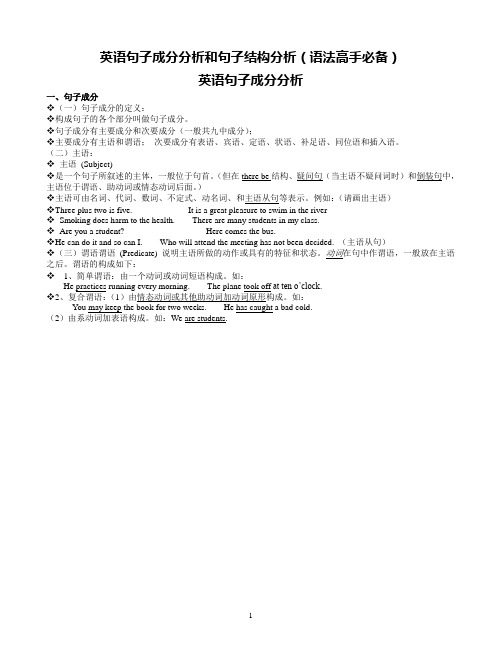
英语句子成分分析和句子结构分析(语法高手必备)英语句子成分分析一、句子成分(一)句子成分的定义:构成句子的各个部分叫做句子成分。
句子成分有主要成分和次要成分(一般共九中成分);主要成分有主语和谓语;次要成分有表语、宾语、定语、状语、补足语、同位语和插入语。
(二)主语:主语(Subject)是一个句子所叙述的主体,一般位于句首。
(但在there be结构、疑问句(当主语不疑问词时)和倒装句中,主语位于谓语、助动词或情态动词后面。
)主语可由名词、代词、数词、不定式、动名词、和主语从句等表示。
例如:(请画出主语)Three plus two is five. It is a great pleasure to swim in the riverSmoking does harm to the health. There are many students in my class.Are you a student? Here comes the bus.He can do it and so can I. Who will attend the meeting has not been decided. (主语从句)(三)谓语谓语(Predicate) 说明主语所做的动作或具有的特征和状态。
动词在句中作谓语,一般放在主语之后。
谓语的构成如下:1、简单谓语:由一个动词或动词短语构成。
如:He practices running every morning. The plane took off at ten o’clock.2、复合谓语:(1)由情态动词或其他助动词加动词原形构成。
如:You may keep the book for two weeks. He has caught a bad cold.(2)由系动词加表语构成。
如:We are students.谓语体现时态和语态。
•时态现在时:一般现在时:现在进行时:现在完成时:现在完成进行时: 过去时:一般过去时:过去进行时:过去完成时:过去将来时:将来时:一般将来时:将来进行时:将来完成时: 语态Is /am/are+---或does/doIs/am/are+doingHas/have +doneHas/have+been+doing Was/were+---或didWas/were+doingHad+doneWould/should+doShall/will+doShall/will+be+doingShall/will+have+doneIs/am/are+Is /am/are+being+Has/have+been+----------------------Was/were+Was/were+being+ Had+been+Would/should+be+ Shall/will+be+-----------------------Shall/will+have+been+(与非谓语比较)非谓语动to doto have doneto be doingto be doneto have been done doinghaving done donebeing done having been done1. She found the door closed.2. Having been told many times, he made the same mistake.3. Given more time, we could do it much better.4. Walking on the street, he came across his former teacher.5. The meeting being held is very important.6. A big fire broke out in a shop, causing 100 deaths.(四)表语表语(Predicative)用以说明主语的性质、特征、状态与身份,它一般位于系动词(如be, become, get, look, grow, turn, seem等)之后。
定语从句的句子成分分析与使用技巧
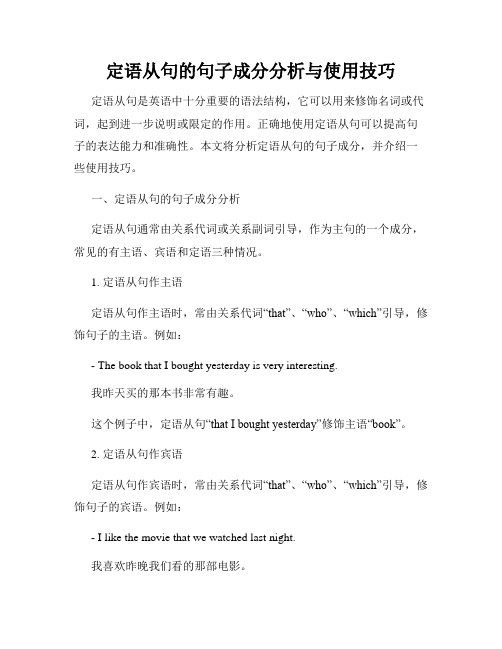
定语从句的句子成分分析与使用技巧定语从句是英语中十分重要的语法结构,它可以用来修饰名词或代词,起到进一步说明或限定的作用。
正确地使用定语从句可以提高句子的表达能力和准确性。
本文将分析定语从句的句子成分,并介绍一些使用技巧。
一、定语从句的句子成分分析定语从句通常由关系代词或关系副词引导,作为主句的一个成分,常见的有主语、宾语和定语三种情况。
1. 定语从句作主语定语从句作主语时,常由关系代词“that”、“who”、“which”引导,修饰句子的主语。
例如:- The book that I bought yesterday is very interesting.我昨天买的那本书非常有趣。
这个例子中,定语从句“that I bought yesterday”修饰主语“book”。
2. 定语从句作宾语定语从句作宾语时,常由关系代词“that”、“who”、“which”引导,修饰句子的宾语。
例如:- I like the movie that we watched last night.我喜欢昨晚我们看的那部电影。
这个例子中,定语从句“that we watched last night”修饰宾语“movie”。
3. 定语从句作定语定语从句作定语时,常由关系代词“that”、“who”、“which”或关系副词“when”、“where”引导,修饰名词或代词。
例如:- The girl who is playing the piano is my sister.弹钢琴的那个女孩是我妹妹。
这个例子中,定语从句“who is playing the piano”修饰名词“girl”。
二、定语从句的使用技巧1. 选择适当的引导词在使用定语从句时,要根据引导词所指的名词或代词的先行词来选择适当的关系代词或关系副词。
例如:- The book that/which I bought yesterday is very interesting.我昨天买的那本书非常有趣。
高一英语句子成份

I.句子成分组成句子的各个部分叫作句子成分。
英语的句子成分和中文的句子成分大致相同,可分为:主语,谓语,宾语,表语,定语,状语,宾语补语。
一、主语——表明句子里所谈的是:“什么人”或“什么物”,主语常用名词、代词或相当于名词的词或短语充当。
例如:Lily likeshernewbike.(名词)莉莉喜欢她的新自行车。
He getsupearlyeveryday.(代词)他每天都起得很早。
TolearnEnglishwell isnoteasy.(不定式短语)学好英语不容易。
二、谓语——说明主语“做什么”、“是什么”或“怎么样”,英语中谓语只能用动词..充当。
例如:We work hard.我们努力工作。
Theboy caught abird.那个男孩逮住一只鸟。
He is myfather.他是我父亲。
Theyall look fine.他们都很好。
谓语和主语在人称和数方面必须保持一致。
例如:三、宾语——宾语是动作行为的对象。
由名词、代词或相当于名词或代词的词或短语充当,和及物动词一起构成谓语,说明主语“做什么”。
例如:Tombought astory-book.(名词)汤姆买了一本故事书。
Isaw him yesterday.(代词)昨天我看到他了。
Hewanted tohaveacupoftea.(不定式短语)他想要一杯茶。
直接宾语和间接宾语——有些及物动词可以有两个宾语,一个指人,一个指物,指人的叫作间接宾语,指物的叫直接宾语。
合称双宾。
例如:Hegave mesomeink.他给了我一些墨水。
间接宾语直接宾语Ourteachertold usaninterestingstory.老师给我妈讲了一个有趣的故事。
间接宾语直接宾语四、表语——说明主语“是什么”或“怎么样”,与连系动词一起构成谓语,表语由名词、形容词、或相当于名词或形容词的词或短语等充当。
例如:Mysisteris anurse.(名词)我的姐姐是一名护士。
英语句子成分及从句简单讲解
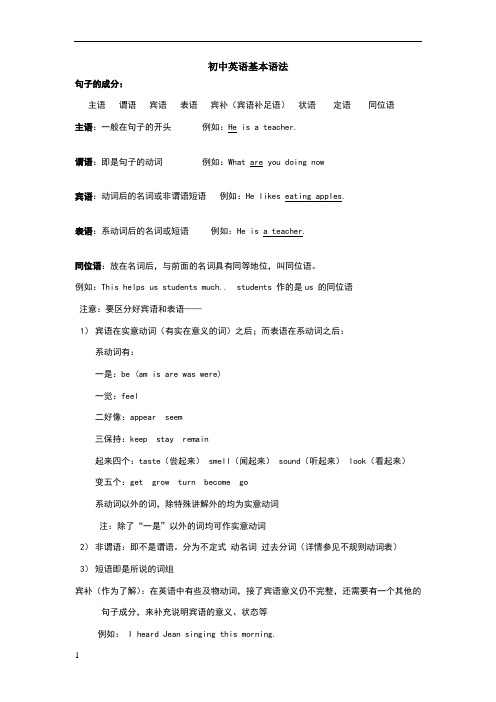
初中英语基本语法句子的成分:主语谓语宾语表语宾补(宾语补足语)状语定语同位语主语:一般在句子的开头例如:He is a teacher.谓语:即是句子的动词例如:What are you doing now宾语:动词后的名词或非谓语短语例如:He likes eating apples.表语:系动词后的名词或短语例如:He is a teacher.同位语:放在名词后,与前面的名词具有同等地位,叫同位语。
例如:This helps us students much.. students 作的是us 的同位语注意:要区分好宾语和表语——1)宾语在实意动词(有实在意义的词)之后;而表语在系动词之后:系动词有:一是:be (am is are was were)一觉:feel二好像:appear seem三保持:keep stay remain起来四个:taste(尝起来) smell(闻起来) sound(听起来) look(看起来)变五个:get grow turn become go系动词以外的词,除特殊讲解外的均为实意动词注:除了“一是”以外的词均可作实意动词2)非谓语:即不是谓语。
分为不定式动名词过去分词(详情参见不规则动词表)3)短语即是所说的词组宾补(作为了解):在英语中有些及物动词,接了宾语意义仍不完整,还需要有一个其他的句子成分,来补充说明宾语的意义、状态等例如: I heard Jean singing this morning.句子中的Jean显然是宾语。
但是主语I听到的并不是Jean,而是Jean singing。
singing 是句子中的宾语补足语。
它和宾语之间是逻辑上的主谓关系,也就是说从逻辑上来讲,是Jean执行了singing的动作。
句子中的singing是现在分词做宾语补足语。
能够充当宾补的还有宾语补足语的大致有:不定式,现在分词,过去分词,形容词,副词,介宾短语等。
英语句型结构与句子成分划分
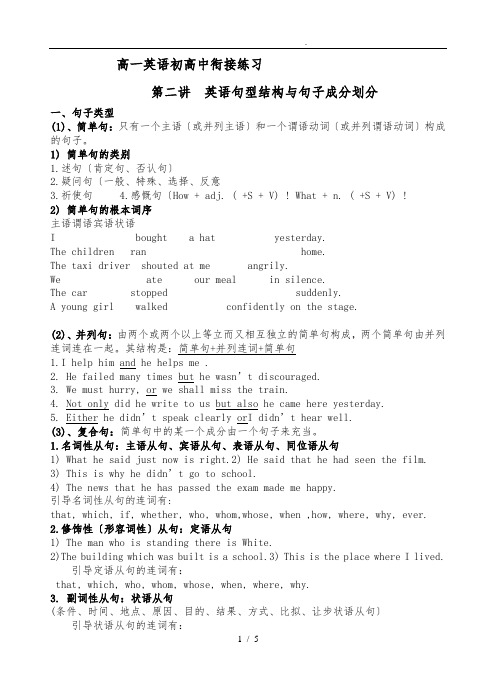
高一英语初高中衔接练习第二讲英语句型结构与句子成分划分一、句子类型(1)、简单句:只有一个主语〔或并列主语〕和一个谓语动词〔或并列谓语动词〕构成的句子。
1) 简单句的类别1.述句〔肯定句、否认句〕2.疑问句〔一般、特殊、选择、反意3.祈使句4.感慨句〔How + adj. ( +S + V) ! What + n. ( +S + V) !2) 简单句的根本词序主语谓语宾语状语I bought a hat yesterday.The children ran home.The taxi driver shouted at me angrily.We ate our meal in silence.The car stopped suddenly.A young girl walked confidently on the stage.(2)、并列句:由两个或两个以上等立而又相互独立的简单句构成,两个简单句由并列连词连在一起。
其结构是:简单句+并列连词+简单句1.I help him and he helps me .2. He failed many times but he wasn’t discouraged.3. We must hurry, or we shall miss the train.4. Not only did he write to us but also he came here yesterday.5. Either he didn’t speak clearly or I didn’t hear well.(3)、复合句:简单句中的某一个成分由一个句子来充当。
1.名词性从句:主语从句、宾语从句、表语从句、同位语从句1) What he said just now is right.2) He said that he had seen the film.3) This is why he didn’t go to school.4) The news that he has passed the exam made me happy.引导名词性从句的连词有:that, which, if, whether, who, whom,whose, when ,how, where, why, ever. 2.修饰性〔形容词性〕从句:定语从句1) The man who is standing there is White.2)The building which was built is a school.3) This is the place where I lived.引导定语从句的连词有:that, which, who, whom, whose, when, where, why.3. 副词性从句:状语从句(条件、时间、地点、原因、目的、结果、方式、比拟、让步状语从句〕引导状语从句的连词有:when, while, as, as soon as, after, since, until, till, where, if, unless, because, in order that, so…that…,though, wherever,whenever, as …as, not so…as, than二. 句子成分划分<1>. 讨论题: 找出以下句子中相应的成分:1.Subject(主语) The sun rises in the east.2.Predicate.〔谓语〕 We study English.3. Object〔宾语〕 We love China.4. Predictive〔表语〕 We are Chinese.5.Attributive/Attribute〔定语〕 This is a difficult problem.pletement(补语) We elected him monitor.7.Adverbial〔状语〕 He runs fast.8.Appositive〔同位语〕 This is Miss Zou, my teacher.9.Parenthesis〔插入语〕To be frank, I don’t agree with you.<2> 句子成分的分类1. 主语: 主语表示句子要说明的人或事物。
高一英语定语从句考点汇总,高一英语学习有方法

高一英语定语从句考点汇总,高一英语学习有方法高一英语定语从句考点汇总概念定语可以由形容词、名词、代词、分词、不定式以及介词短语等来担任,也可以由一个句子来充当,充当定语功能的句子称为定语从句。
定语从句“三要素”1.先行词:被定语从句所修饰的名词或代词①指人的先行词②指物的先行词the same as...和the same that...引导定语从句的区别This is the same bike that I lost yesterday. (同一事物)This is the same bike as I lost yesterday. (同类事物)5.关系副词的运用(1)When 在定语从句中做时间状语,先行词为表示时间的time, day等I still remember the day when I first came to Beijing. (when=on which)(2)Where 在定语从句中做地点状语,先行词为表地点的place, spot等 Can you tell me the office where he works?(where = in which)(3)Why 在定语从句中做原因状语,先行词只有reason.I don’t want to listen to any reason why you were absent.(why = for which)Where引导的定语从句还可以修饰抽象空间的名词如case(情形),situation, position(位置),stage (阶段),point(地步)等What are the situations where body language is the only form of communication?在哪些情况下身体语言是唯一的沟通方式。
(此时where = in which) 6.几个特殊的先行词(1)way在定语从句中做状语时的三种引导方式 that / in which / 不填The way in which / that / 不填 he e某plains the sentence to usis quite simple.比较:The way which /that/不填 he told to us was quite simple.此时when = during which 在..期间(3)先行词reason当在定语从句中作状语时,定语从句的4种引导方式why/for which/that/不填This is the reason why/for which/that/不填 he can not come here.比较:Is this the reason that/which/不填he e某plained to us for his absence from the conference.该结构的关系代词只有两种即介词+which(指物) 介词+whom(指人)★该结构介词的选用原则:(1)根据定语从句中谓语动词的习惯搭配This is the book on which I spent $ 8.This is the book for which I paid $ 8.(2)根据先行词的搭配习惯I remember the days during which I lived there.I remember the day on which I graduated from university.(3)根据整个句子所表达的意思来决定The colorless gas without which we can’t live is called o某ygen.(4)英语中为了强调某一名词,不定式前面也可以加上关系代词。
高中英语定语从句详解
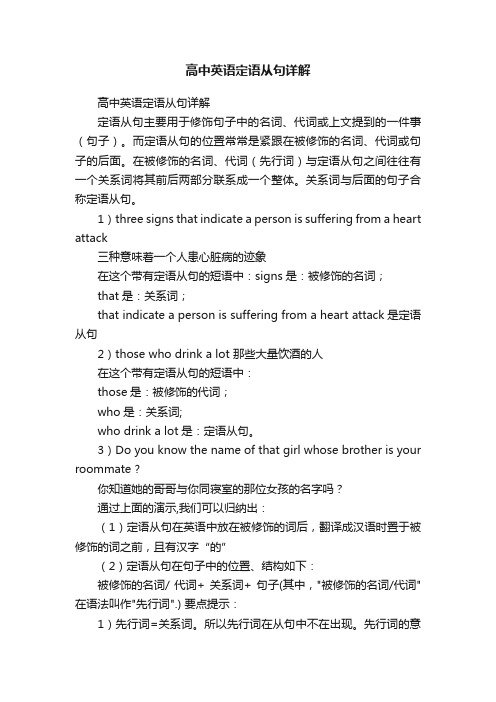
高中英语定语从句详解高中英语定语从句详解定语从句主要用于修饰句子中的名词、代词或上文提到的一件事(句子)。
而定语从句的位置常常是紧跟在被修饰的名词、代词或句子的后面。
在被修饰的名词、代词(先行词)与定语从句之间往往有一个关系词将其前后两部分联系成一个整体。
关系词与后面的句子合称定语从句。
1)three signs that indicate a person is suffering from a heart attack三种意味着一个人患心脏病的迹象在这个带有定语从句的短语中:signs是:被修饰的名词;that是:关系词;that indicate a person is suffering from a heart attack是定语从句2)those who drink a lot 那些大量饮酒的人在这个带有定语从句的短语中:those是:被修饰的代词;who是:关系词;who drink a lot是:定语从句。
3)Do you know the name of that girl whose brother is your roommate ?你知道她的哥哥与你同寝室的那位女孩的名字吗?通过上面的演示,我们可以归纳出:(1)定语从句在英语中放在被修饰的词后,翻译成汉语时置于被修饰的词之前,且有汉字“的”(2)定语从句在句子中的位置、结构如下:被修饰的名词/ 代词+ 关系词+ 句子(其中,"被修饰的名词/代词"在语法叫作"先行词".) 要点提示:1)先行词=关系词。
所以先行词在从句中不在出现。
先行词的意义以及它在从句中的语法功能(句子成分)决定关系词的选择。
定语从句中的关系词只有两类:关系代词和关系副词;所有关系词不但都有具体的意义而且都在从句中担任一定的成分。
1)关系代词:who , whom , whose , which , that 等。
句子成分分析及定语从句-高一英语

句子成分分析讲解--2013-5-1英语中,句子分为简单句和复合句【简单句的五种基本句型】A. 主语+不及物动词(主谓)B. 主语+及物动词+宾语(主谓宾)C. 主语+系动词+表语(主系表)D. 主语+及物动词+双宾语(直接宾语、间接宾语)(主谓+直宾+间宾)E. 主语+及物动词+宾语+宾语补足语(主+谓+宾+宾补)【句子的成分】在英文中句子成分包括:主语、谓语、宾语(直接宾语、间接宾语)、表语、定语和状语、宾语补足语等。
(一)主语:主语是谓语讲述的对象,表示所说的“是什么”或“是谁”。
一般由名词、代词、不定式或相当于名词的词或短语来充当。
它一般在句首。
如:(1)Lucy is a beautiful nurse. (名词作主语)(2)He reads newspapers every day. (代词作主语)(3)Smoking is harmful to the health. (动名词作主语)(4)To swim in Kunming Lake is a great pleasure.(不定式作主语)(5)What we should do is not yet decided. (主语从句作主语)(二)谓语说明主语“做什么”“是什么”或“怎么样”两方面必须一致。
它一般在主语后面。
如:His parents are teachers. (系动词和表语一起作谓语)We study hard. (行为动词作谓语)We don’t finish reading the book. (助动词和行为动词一起作谓语)He can speak English. (情态动词和行为动词一起作谓语)(三)宾语宾语是动作、行为的对象,由名词、代词、不定式或相当于名词的词、短语来担任,它和及物动词一起说明主语做什么。
一般放在谓语之后。
She is doing her homework now.(名词作宾语)She says(that)she is ill.(宾语从句作动词宾语)We often help him.(代词作宾语)He likes to play basketball.(不定式作宾语)We enjoy listening to the music. 我们喜欢听音乐。
高一英语句子成分

篇一:高中英语句子成分和句子种类文档句子成分和句子种类详解句子成分和结构是英语的基础,是理解和表达英语的关键。
英语中许多词类都对句子成分和结构有影响。
英语中的句子是由词或短语组成的,这些词或短语在句子中起一定的作用,叫做句子成分。
英语的篇章是由句子构成的,不同的内容需要不同类型的句式结构,这些句式结构又构成英语中不同的句子类型。
学习英语句法的基础是了解句子成分、句子的基本结构和句子种类。
i 句子成分组成句子的各个部分叫做句子成分。
句子成分包括主语、谓语、表语、宾语、同位语、定语、状语和补足语等。
主语和谓语是句子的主体部分;表语、宾语、定语、状语、补足语和同位语等是句子的次要部分。
1. 主语:主语说明谓语动作或状态的执行者,常用的作主语的词类有:名词(短语)、代词、数词、不定式(短语)、动名词(短语)和从句。
1)名词:the students are learning grammar.our teacher speaks very fast.2)代词:she is writing.he likes playing tennis.3)数词:five is an odd number.six is my favourite number.4)不定式:to learn english well is important.it is not easy to remember all rules.5)动名词:swimming is interesting.learning grammar well is difficult.6)主语从句:what i said is true.what we cant get seems better than what we have.2. 谓语:谓语用来描述主语的行为动作或所处的状态。
谓语的中心词是限定动词,有人称、数和时态的变化。
1)简单谓语动词:he bought a dictionary yesterday.动词短语:he is looking for his pen.2)复合谓语系动词+表语:we are students.情态动词+不定式:i may be wrong.动词+不定式:we have to do something for them.3. 表语:表语与前面的系动词一起构成复合谓语,用来说明主语的特征、类属、状态、身份等。
英语句子成分分析分析解析

英语句子成分分析分析解析在英语中,句子可以被分解为不同的成分,包括主语、动词、宾语、定语和状语等。
下面是一些常见的句子成分及其分析解析:1. 主语(Subject):句子中的主要人或事物,执行动作或被动作所指向。
例如:I went to the store.分析:主语是I。
2. 谓语(Predicate):句子中的动作或状态,表达主语的行为。
例如:She is reading a book.分析:谓语是 is reading。
3. 宾语(Object):动词的直接接收者或受益者。
例如:He bought a new car.分析:宾语是 a new car。
4. 定语(Adjective):修饰名词或代词的形容词或词组。
例如:The big dog chased the cat.分析:定语是 big。
5. 状语(Adverb):修饰动词、形容词或其他副词的副词或词组。
例如:She runs quickly.分析:状语是 quickly。
例如:He became a doctor.分析:补语是 a doctor。
7. 同位语(Appositive):对名词或代词作进一步解释或补充说明。
分析:同位语是 John。
8. 状语从句(Adverbial Clause):起状语作用的从句。
9. 定语从句(Adjective Clause):起定语作用的从句。
例如:The book that I bought is very interesting.分析:定语从句是 that I bought。
以上是一些常见的英语句子成分及其分析解析。
要准确理解和运用句子成分,需要对语法规则有一定的了解,并在实践中积累经验。
英语语法分析-句子成分分析
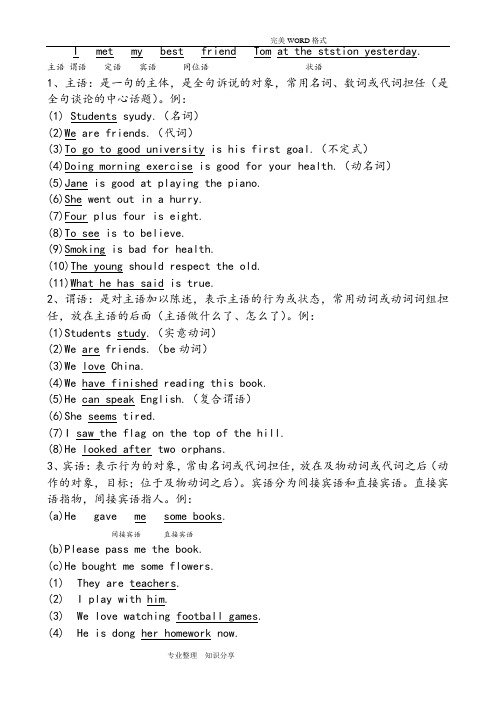
I met my best friend Tom at the ststion yesterday.主语谓语定语宾语同位语状语1、主语:是一句的主体,是全句诉说的对象,常用名词、数词或代词担任(是全句谈论的中心话题)。
例:(1) Students syudy.(名词)(2)We are friends.(代词)(3)To go to good university is his first goal.(不定式)(4)Doing morning exercise is good for your health.(动名词)(5)Jane is good at playing the piano.(6)She went out in a hurry.(7)Four plus four is eight.(8)To see is to believe.(9)Smoking is bad for health.(10)The young should respect the old.(11)What he has said is true.2、谓语:是对主语加以陈述,表示主语的行为或状态,常用动词或动词词组担任,放在主语的后面(主语做什么了、怎么了)。
例:(1)Students study.(实意动词)(2)We are friends.(be动词)(3)We love China.(4)We have finished reading this book.(5)He can speak English.(复合谓语)(6)She seems tired.(7)I saw the flag on the top of the hill.(8)He looked after two orphans.3、宾语:表示行为的对象,常由名词或代词担任,放在及物动词或代词之后(动作的对象,目标;位于及物动词之后)。
宾语分为间接宾语和直接宾语。
句子成分分析及定语从句-高一英语概要
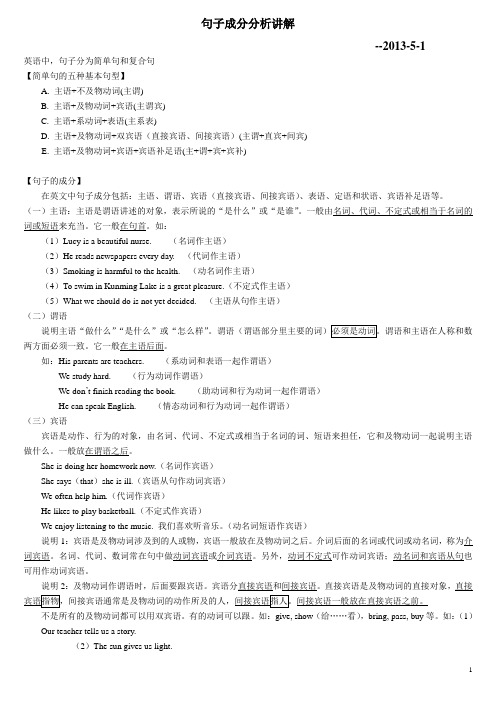
句子成分分析讲解--2013-5-1英语中,句子分为简单句和复合句【简单句的五种基本句型】A. 主语+不及物动词(主谓)B. 主语+及物动词+宾语(主谓宾)C. 主语+系动词+表语(主系表)D. 主语+及物动词+双宾语(直接宾语、间接宾语)(主谓+直宾+间宾)E. 主语+及物动词+宾语+宾语补足语(主+谓+宾+宾补)【句子的成分】在英文中句子成分包括:主语、谓语、宾语(直接宾语、间接宾语)、表语、定语和状语、宾语补足语等。
(一)主语:主语是谓语讲述的对象,表示所说的“是什么”或“是谁”。
一般由名词、代词、不定式或相当于名词的词或短语来充当。
它一般在句首。
如:(1)Lucy is a beautiful nurse. (名词作主语)(2)He reads newspapers every day. (代词作主语)(3)Smoking is harmful to the health. (动名词作主语)(4)To swim in Kunming Lake is a great pleasure.(不定式作主语)(5)What we should do is not yet decided. (主语从句作主语)(二)谓语说明主语“做什么”“是什么”或“怎么样”两方面必须一致。
它一般在主语后面。
如:His parents are teachers. (系动词和表语一起作谓语)We study hard. (行为动词作谓语)We don’t finish reading the book. (助动词和行为动词一起作谓语)He can speak English. (情态动词和行为动词一起作谓语)(三)宾语宾语是动作、行为的对象,由名词、代词、不定式或相当于名词的词、短语来担任,它和及物动词一起说明主语做什么。
一般放在谓语之后。
She is doing her homework now.(名词作宾语)She says(that)she is ill.(宾语从句作动词宾语)We often help him.(代词作宾语)He likes to play basketball.(不定式作宾语)We enjoy listening to the music. 我们喜欢听音乐。
高一英语-句子成分分析-语法总结大全

Байду номын сангаас
S V P (主+系+表)
S V o O (主+谓+间宾+直宾)
S V (主+谓)
S V O (主+谓+宾)
S V O C (主+谓+宾+宾补)
基本句型 一:S V (主+谓) 主语:可以作主语的成分有名词(如boy),主格代词(如you),数词,名词化的形容词,动词不定式,动名词或从句。主语一般在句首。注意名词单数形式常和冠词不分家! 谓语:谓语由动词构成,是英语时态、语态变化的主角,一般在主语之后。不及物动词(vi.)没有宾语,形成主谓结构,如:We come. 此句型的句子有一个共同特点,即句子的谓语动词都能表达完整的意思,不能再接对象(即宾语),这类动词叫做不及物动词,后面可以跟副词、介词短语、状语从句等作状语。
基本句型 二: S V P (主+系+表) 此句型的句子有一个共同的特点:句子谓语动词都不能表达一个完整的意思,必须加上一个表明主语性质,特征,状态或身份的表语构成复合谓语,才能表达完整的意思。这类动词叫做连系动词。 系动词分三类:1)表示人或事物的身份特征或状态:appear, be, feel , look, seem, smell,sound, taste。例如 look well/面色好,sound nice/听起来不错,feel good/感觉好,smell bad/难闻,taste good/尝起来不错; 2)表示状态的变化:become,come,fall,go,get, grow, turn,prove等;例如become cold/变冷,go grey/变灰白, (dreams) come true/(梦想)实现;3)表示某种状态的延续或持续:continue,remain, stay, keep 等。例如keep silent/保持沉默,stay fine/仍然很好 。 注意be 本身没有什么意义,只起连系主语和表语的作用。其它系动词仍保持其部分词义。 表语通常由名词n. 代词pron. 形容词adj. 数词,副词adv. 介词短语prep.phr.,动词不定式to-do,现在分词,或从句等担任。
高一英语培优提升暑假作业:2必修第一册重要语法突破讲义(人教版2019)(原卷版)
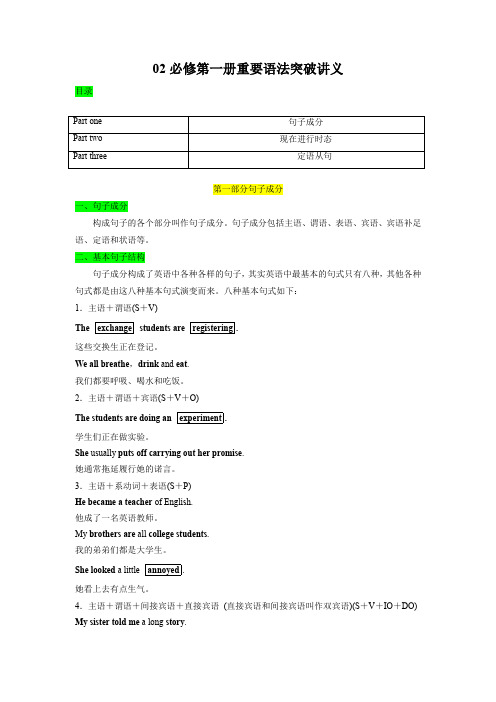
02必修第一册重要语法突破讲义目录第一部分句子成分一、句子成分构成句子的各个部分叫作句子成分。
句子成分包括主语、谓语、表语、宾语、宾语补足语、定语和状语等。
二、基本句子结构句子成分构成了英语中各种各样的句子,其实英语中最基本的句式只有八种,其他各种句式都是由这八种基本句式演变而来。
八种基本句式如下:1.主语+谓语(S+V)The exchange students are registering.这些交换生正在登记。
We all breathe,drink and eat.我们都要呼吸、喝水和吃饭。
2.主语+谓语+宾语(S+V+O)The students are doing an experiment.学生们正在做实验。
She usually puts off carrying out her promise.她通常拖延履行她的诺言。
3.主语+系动词+表语(S+P)He became a teacher of English.他成了一名英语教师。
My brothers are all college students.我的弟弟们都是大学生。
She looked a little annoyed.她看上去有点生气。
4.主语+谓语+间接宾语+直接宾语(直接宾语和间接宾语叫作双宾语)(S+V+IO+DO) My sister told me a long story.我姐姐给我讲了一个很长的故事。
The professor gave us an exciting lecture.教授给我们做了一场激动人心的讲座。
5.主语+谓语+宾语+宾补(宾语和宾补统称为复合宾语)(S+V+O+C) I found his design very impressive.我发现他的设计让人印象深刻。
She kept us waiting for her answer for over a week.她让我们等她的回音等了一个多星期。
2月19日英语句子成分分析(宾语从句+定语从句)
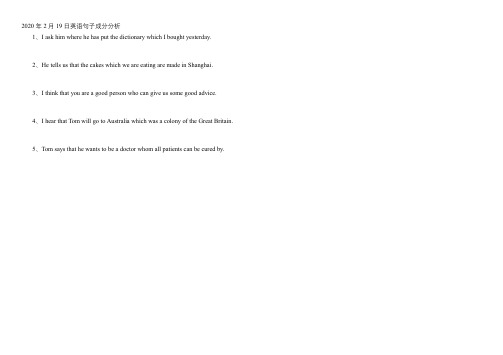
1、I ask him where he has put the dictionary which I bought yesterday.2、He tells us that the cakes which we are eating are made in Shanghai.3、I think that you are a good person who can give us some good advice.4、I hear that Tom will go to Australia which was a colony of the Great Britain.5、Tom says that he wants to be a doctor whom all patients can be cured by.1、I ask him主句:主谓间宾直宾(从句)修饰宾语从句中dictionary的定语从句从句1:状语主谓宾从句2:先行词关系代词-宾主谓时间状语2、He tells us that the cakes which we are eating are made in Shanghai.主句:主谓间宾直宾(从句)修饰宾语从句中cakes 的定语从句从句1:主谓地点状语从句2:先行词关系代词-宾主谓3、I think that you are a good person who can give us some good advice.主句:主谓宾语(从句)修饰宾语从句中person 的定语从句从句1:主系表从句2:先行词关系代词-主谓间宾直宾4、I hear that Tom will go to Australia which was a colony of the Great Britain.主句:主谓宾语(从句)修饰宾语从句中Australia 的定语从句从句1:主谓地点状语从句2:关系代词-主系表5、Tom says that he wants to be a doctor whom all patients can be cured by.主句:主谓宾语(从句)修饰宾语从句中doctor的定语从句从句1:主谓宾从句2:先行词关系代词-宾主谓介词。
人教版高一英语必修2定语从句课件共33张

when, where, why与that, which的区分
• 1. I’ll never forget the dayw__h_e_n_/o_n__w__h_i_ch
we first met in the park.
• 2. I’ll never forget the time w__h_i_c_h_/t_h_a_t_
as 的使用
The earth is round, _a_s_/_w_h_i_c_h_is known to all.
_A_s_ is known to all, the earth is round. _I_t_ is known to all that the earth is round. 定语从句在句首时只能用as, as具有
6)there be 句型时,引导定语从句用that。
1. Her bag, in _w_h_i_c_h_ she put all her money, has been stolen.
她的包包已经被偷了,她所有的钱都在里面。
2. Xiao Wang, with _w_h_o_m__ I went to the concert, enjoy it very much.
这是大家都喜欢的如此有趣的一本书。
This is such an interesting book _a_s_ we
all like.
This is so interesting a book _a_s_ we all
like.
定语从句
先行词受such,so,the same修饰时,常用as.
这本书如此有趣,大家都喜欢。 This is such an interesting book _t_h_a_t we all like it. This is so interesting a book _t_h_a_t we all like it. 结果状语从句
高一英语定语从句
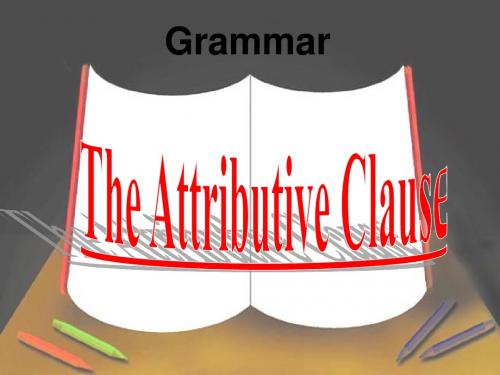
3. 指物的先行词被序数词或形容词最高级修 饰时: The first step (that) we are to take is very difficult. This is the second card (that) he gave me. 4. 先行词是指物的不定代词all, little, few, much, everything, anything, nothing等时: There is still much that can be done about it. Have you got everything (that) you need? 5. 先行词是who时:Who that have seen him does not like him?
We are facing the same problems as we did years ago. Some people have no doubt that their cat understands as/so many words as a dog does. We hope to get such a tool as he is using. He’s such a good student as everyone likes . He’s such a good student that everyone likes him.
I’d like a room whose window looks out over the sea.
I’d like a room the window of which looks out over the sea.
He has a friend whose father is a doctor. He has a friend the father of whom is a doctor.
高中英语句子成分分析 定语从句

1. The war was over. 2. They seem to know the truth. 3. Time is precious. 4. I’m not quite myself today. 5. Who was the first? 6. He is out of condition. 7. The book is what I need.
• He got up so late that he missed the train.
• I waited to see you. • He often went to school by bus. • His parents died,leaving him an
orphan. • Please call me if it is necessary. • This book is very interesting. • He went to school in spite of his
表语从句
3、I know this boy.
I know what you mean. 宾语从句
4、she lives in London.
she lives where there is a big tree. 状语语从句
5、She is a She is a
beautiful
girl.
定语从句
girl who is beautiful.
The Attributive Clause
1.定义:attributive clause is clause to modify a nun or pron in a complex sentence.
2.关键词:先行词, 关系代词,关系副词
- 1、下载文档前请自行甄别文档内容的完整性,平台不提供额外的编辑、内容补充、找答案等附加服务。
- 2、"仅部分预览"的文档,不可在线预览部分如存在完整性等问题,可反馈申请退款(可完整预览的文档不适用该条件!)。
- 3、如文档侵犯您的权益,请联系客服反馈,我们会尽快为您处理(人工客服工作时间:9:00-18:30)。
句子成分分析讲解--2013-5-1英语中,句子分为简单句和复合句【简单句的五种基本句型】A. 主语+不及物动词(主谓)B. 主语+及物动词+宾语(主谓宾)C. 主语+系动词+表语(主系表)D. 主语+及物动词+双宾语(直接宾语、间接宾语)(主谓+直宾+间宾)E. 主语+及物动词+宾语+宾语补足语(主+谓+宾+宾补)【句子的成分】在英文中句子成分包括:主语、谓语、宾语(直接宾语、间接宾语)、表语、定语和状语、宾语补足语等。
(一)主语:主语是谓语讲述的对象,表示所说的“是什么”或“是谁”。
一般由名词、代词、不定式或相当于名词的词或短语来充当。
它一般在句首。
如:(1)Lucy is a beautiful nurse. (名词作主语)(2)He reads newspapers every day. (代词作主语)(3)Smoking is harmful to the health. (动名词作主语)(4)To swim in Kunming Lake is a great pleasure.(不定式作主语)(5)What we should do is not yet decided. (主语从句作主语)(二)谓语说明主语“做什么”“是什么”或“怎么样”。
谓语(谓语部分里主要的词)必须是动词。
谓语和主语在人称和数两方面必须一致。
它一般在主语后面。
如:His parents are teachers. (系动词和表语一起作谓语)We study hard. (行为动词作谓语)We don’t finish reading the book. (助动词和行为动词一起作谓语)He can speak English. (情态动词和行为动词一起作谓语)(三)宾语宾语是动作、行为的对象,由名词、代词、不定式或相当于名词的词、短语来担任,它和及物动词一起说明主语做什么。
一般放在谓语之后。
She is doing her homework now.(名词作宾语)She says(that)she is ill.(宾语从句作动词宾语)We often help him.(代词作宾语)He likes to play basketball.(不定式作宾语)We enjoy listening to the music. 我们喜欢听音乐。
(动名词短语作宾语)说明1:宾语是及物动词涉及到的人或物,宾语一般放在及物动词之后。
介词后面的名词或代词或动名词,称为介词宾语。
名词、代词、数词常在句中做动词宾语或介词宾语。
另外,动词不定式可作动词宾语;动名词和宾语从句也可用作动词宾语。
说明2:及物动词作谓语时,后面要跟宾语。
宾语分直接宾语和间接宾语。
直接宾语是及物动词的直接对象,直接宾语指物,间接宾语通常是及物动词的动作所及的人,间接宾语指人。
间接宾语一般放在直接宾语之前。
不是所有的及物动词都可以用双宾语。
有的动词可以跟。
如:give, show(给……看),bring, pass, buy等。
如:(1)Our teacher tells us a story.(2)The sun gives us light.间接宾语如果放在直接宾语之后,在表示“人”的间接宾语之前会出现介词“to”或“for”。
间接宾语前加“to”的有:give, show, send, bring, read, pass, lend, leave, hand, tell, return, write, throw, promise(答应), refuse(拒绝)等。
间接宾语加“for”的有:make, buy, do, get, play, order(命令), sing, pay等(1)I give him a book. 改成:(2)He passes me the book.(他将书递给我。
)改成:(3)He writes me a letter. 改成:(4)He will buy me some books. 改成:(5)She is making me a cake. 改成:(四)宾语补足语在宾语后面补充说明宾语的动作、状态、特征的成分,称为宾语补足语。
名词、形容词、副词、介词短语以及动词不定式、分词等可用作宾语补足语。
宾语和宾语补足语称为复合宾语。
如:They make her happy.(形容词)I see her dance.(不定式)We’ll help y ou to make the Olympics a success.(名词)Please let him in.(副词)We heard her singing a song.(分词短语)(五)表语表语说明主语“是什么”或者“怎么样”,由名词、形容词、副词、介词、不定式及相当于名词或形容词或短语来担任。
它的位置在系动词后面。
如:I am a teacher.(名词)He is always happy.(形容词)They are on the playground now.(介词短语)It gets cold.(形容词)Be动词(am,is,are, was, were)系动词表保持(keep, stay, remain)表改变(get,become,turn)感官动词(feel,sound(听起来),seem/look(看起来),taste(尝起来),smell(闻起来))如:It sounds interesting.(sound为系动词,interesting为表语)We should all remain careful. Remain(为系动词,careful为表语)(六)定语定语是用来修饰名词或代词的。
形容词、代词、数词、名词、介词短语、不等式或相当于形容词的词或短语等。
单个词作定语时,通常放在它所修饰的名词之前。
如:The black bike is mine.(形容词)What’s your name?(代词)They make paper flowers.(名词)说明1:当定语修饰不定代词:nothing, anything, everything, something等时,定语在不定代词后面。
如:I tell him something interesting. (形容词interesting作不定代词something的后置定语)He has something to do. (to do为不定式作后置定语)说明2:短语或从句作定语时,也放在被修饰的名词之后。
如:The boys in the room are in Class Four. (in the room是介词短语作the boys的后置定语。
)(七)状语修饰动词、形容词、副词。
一般表示行为发生的时间、地点、目的、方式、程度等意义,一般由副词、介词短语、不定式或相当于副词的词或短语来表示。
状语一般放在句末,但有的可以放在句首、句中。
如:He did it carefully.(副词)We often help him.(副词)Her mother goes out to do some shopping on Sunday.(介词短语)When I grow up, I am going to be a teacher.(从句作时间状语)He sits there.(副词地点状语)同步练习指出划线部分的句子成分。
1. Lily is cleaning the desk now. 1. 主,谓,宾,状2. Her garden is the best in our town. 2. 定,状3. Liu Ming is thirteen years old. 3. 表4. I like this book very much. 4. 谓,宾,状sister. 5. 定,定5. The girl on the blue bike is Jane’sto my party because she was ill. 6. 谓,状6. She didn’t come7. Wang Ping does his homework carefully. 7. 谓,宾,状once a week. 8. 谓,状8. We will go to the Children’s Palace9. They are in the classroom. 9. 表10. It sounds good. 10. 表11. His name is Paul. 11. 定,表12. We always go to school early . 状,状定语从句-The Attributive ClausesTeaching Aim: 1 To review common knowledge on the Attributive Clauses.2 To develop the ability to use the Attributive Clauses.1、概念:在复合句中,修饰某一名词或代词的从句叫定语从句。
被修饰的名词或代词叫先行词,定语从句一般放在先行词的后面,起补充说明或者修饰的作用。
限制性定语从句:The Restrictive Attributive(限制性定语从句紧跟先行词,主句与从句不用逗号分开,从句不可省去)2、分类:非限制性定语从句:The Non- Restrictive Attributive(非限制性定语从句主句与从句之间有逗号分开,起补充说明作用,如省去,意思仍完整、清晰)3.★定语从句考点归纳1.that与which;2.如何判断介词;3.whose的使用;4.as 的使用;5.when,where.why与that,which的区分;6.定语从句的动词的数。
4.代词的用法1). that 既可以用于指人,也可以用于指物。
在从句中作主语或宾语,作主语时不可省略,作宾语可省略。
例如:Mary likes music that is quiet and gentle.玛丽喜欢轻柔的音乐。
(that作主语)The coat (that)I put on the desk is blue.我放在桌子上的那件外套是蓝色的。
(that作宾语)2).which用于指物,在句中作主语或宾语,作主语不可省略,作宾语可省略。
例如:The building which stands near the train station is a supermarket.位于火车站附近的那座大楼是一家超市。
(作主语)The film (which)we saw last night was wonderful. 我们昨天晚上看的那部电影很好看。
